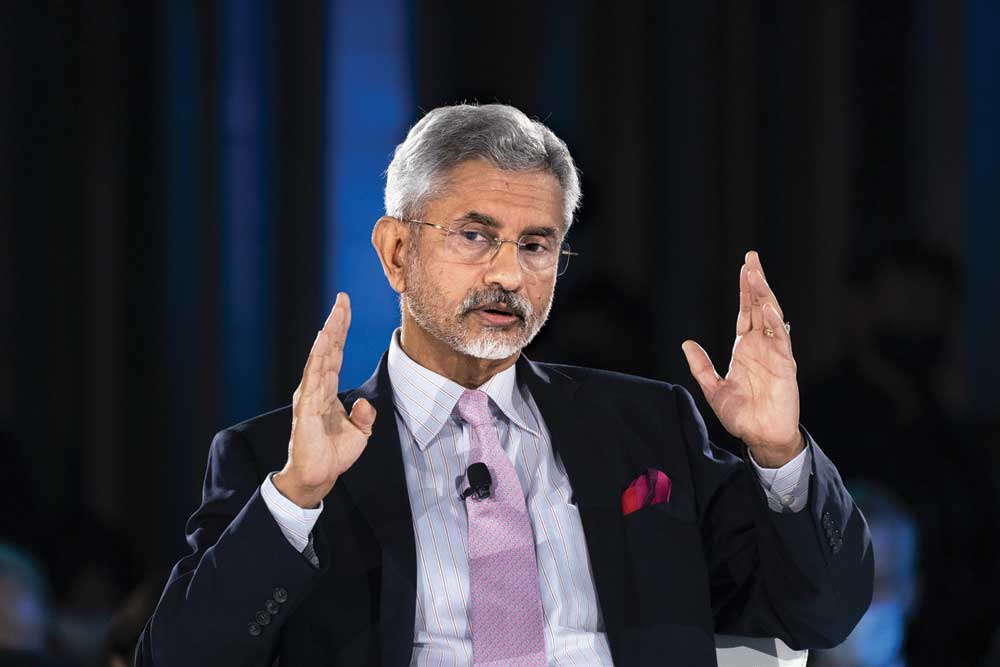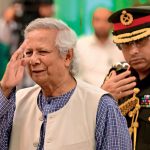Modi-Joey Bhai Bhai
The strategic calculation that underlies America’s great enthusiasm for India
 James Astill
James Astill
 James Astill
James Astill
 |
24 Jun, 2023
|
24 Jun, 2023
/wp-content/uploads/2023/06/Modi-Joe1.jpg)
Prime Minister Narendra Modi and US President Joe Biden on the South Lawn of the White House, June 22, 2023 (Photo: AP)
JOE BIDEN HAS HELD three state dinners since he entered the White House in 2021. He held the first two, with the presidents of France and South Korea, because he had to. France is America’s oldest ally and counts on getting the full White House banquet treatment almost every presidential term. South Korea, also an ally and home to 30,000 US troops, is guaranteed a state dinner once a decade. By contrast, India, which is not a formal US ally and probably never will be, is entitled to no such American feasting. Biden hosted Narendra Modi on the White House’s South Lawn, amid green drapes and gorgeous saffron-coloured flower arrangements, not because he had to, but because he wanted to.
US’ two-decades-long enthusiasm for closer ties with India is as robust as it is strange. Ever since President George W Bush decided, in the early 2000s, to negotiate a civil-nuclear cooperation agreement with India, the US has made an India-sized exception to its diplomacy as usual. Despite India’s non-ally status, Bush’s two successors, Barack Obama and Donald Trump, both visited India and sent their senior officials to Delhi in droves. India, Obama would write in his presidential memoir, “always has a special place in my imagination.” (Maybe, he pondered, it was because of his childhood times in Indonesia listening to the Ramayana and Mahabarata.) “America loves India!” roared Trump, at a political rally he attended with Modi in Ahmedabad.
The closeness of US-India ties did slow a bit under Trump. He launched a mini-trade war on India, hiking duties on around 15 per cent of India’s exports to America. But that was nothing compared to the tariffs he slapped on $300 billion of Chinese goods— or even those he placed on $6 billion of European steel imports. Overall, the constancy of America’s reach-out to India is far more striking than its occasional disruption.
At a time of extreme polarisation in Washington, the importance of US-India ties can seem like the only thing Republicans and Democrats agree on, indeed. I never once, during eight years working on and around Capitol Hill, heard a congressional member or staffer speak against them in earnest.
BUSH’S FUNDAMENTAL STRATEGIC calculation: that a rising, populous India is the only possible Asian counterweight to China, underlies America’s great Indian enthusiasm—which was apparent on Capitol Hill, as well as the White House, when Modi addressed a joint gathering of its two congressional chambers for the second time. This was an honour previously afforded only to the closest of American allies: to the likes of Winston Churchill, Nelson Mandela and Volodymyr Zelensky.
As US-India defence cooperation has increased, and as China asserted itself along the northern border, India has embraced the partnership’s strategic dimension, as well as its economic one. India’s armed forces exercise more with US forces than those of any other country. Outspoken anti-Americanism has become peripheral in Indian politics. Modi, who has a huge following in the vibrant Indian American diaspora, describes the relationship far more warmly than his Congress predecessors did
Unused to America’s attentions—and with a memory of the anti-Americanism that pervaded Delhi during the Cold War— India was initially more guarded about the partnership. The Congress-led UPA governments, which only narrowly succeeded in winning domestic approval for the nuclear cooperation deal, had their anti-American communist allies to keep on side. They also looked to the US mainly as an economic opportunity, in part because of a fear that the US would ask India to abandon its longstanding security ties to Russia. But under Modi, this reticence has been largely jettisoned.
As US-India defence cooperation has increased, and as China asserted itself along the northern border, India has embraced the partnership’s strategic dimension, as well as its economic one. India’s armed forces exercise more with US forces than those of any other country. Outspoken anti- Americanism has become peripheral in Indian politics. Modi, who has a huge following in the vibrant Indian American diaspora, describes the relationship far more warmly than his Congress predecessors did. The prime minister went so far as to describe the two countries as “natural allies”.
But this does not mean India is bending to American will, as the US generally expects its allies to do. India is not for bending—as Foreign Minister Subrahmanyam Jaishankar made clear to me and two of my colleagues at The Economist, during an hour-long interview in his office at South Block ahead of Modi’s trip.
It was a significant interview. Modi is the star turn of India’s accelerating global engagement. Politicians in America and everywhere are beguiled by his charismatic leadership, and even more by his hold on Indian voters. (“Modi is the boss!” gushed Australia’s Prime Minister Anthony Albanese.) Yet, Jaishankar has emerged as a hugely important support act, with a global fan club of his own. In a recent interview with The Economist—ahead of his 100th birthday—Henry Kissinger praised the Indian foreign minister as “the practising political leader that is quite close to my views.”
The former secretary of state and doyen of American foreign policy appreciates Jaishankar’s cerebral style. Few foreign policy practitioners have the intellectual confidence or mastery of a brief of the former foreign secretary. (Jake Sullivan, Biden’s intellectual national security advisor, is among those few.) Yet, Kissinger also approves of Jaishankar’s actual views. They are, in foreign policy terms, fundamentally realist, and in that sense, similar to Kissinger’s own.

THERE MAY BE, amid the enthusiasm for India, a dawning understanding in Washington that it is not the same sort of biddable US partner as Japan or South Korea. Yet, outside Biden’s experienced foreign policy team, there remains an assumption that India will end up moving in that more swayable direction. Washington decision-makers, by and large, still see global affairs in terms of those who are with the US and those, chiefly China, who are not. Jaishankar sees things differently. He sees an emerging dance of great powers, including chiefly the US, China, India and Russia, in which India will try to engage several partners at once. “We would like to have multiple choices. And obviously try to make the best of it,” he told us during the interview. “Every country would like to do that. Some may be constrained by other obligations, some may not.”
It is a highly transactional view. In his recent book, The India Way: Strategies for an Uncertain World, Jaishankar describes that world as a “transactional bazaar”—a “multipolar world with frenemies.” Yet, he stresses, this does not preclude possibilities of long-term alignments of interest (or frenemyships?). India’s partnership with the US is a case in point. He described it as “on the right track and moving forwards very, very rapidly.” And he credited much of that to the forward momentum Modi, eschewing his predecessors’ caution, has brought: “For the last decade, you have had a government which does not have those ideological hesitations. So, you will see the relationship move forward much more smoothly.”
This does not mean India is bending to American will, as the US generally expects its allies to do. India is not for bending—as foreign minister Subrahmanyam Jaishankar made clear to me and my colleagues at The Economist, during an hour-long interview in his office at South Block ahead of Modi’s trip
Of course, India has long-time alignments elsewhere, too—including with Russia. And to those, mainly rights activists and in the media, who are currently finding that unconscionable, Jaishankar offers not even a recognition of their terms of debate. He does not believe India is taking a pass on its moral obligations in refusing to condemn Putin. Because he does not accept that such moral niceties have a place in great power politics. “The Russia relationship is an outcome of 60 years of history,” he told us. “And after 60 years of history, it’s not as though you say, ‘I’ve changed my mind.’ That’s not the way real life works.” India has an interest in maintaining its strategic partnership with Russia, the source of most of its defence imports and, currently, around half of its oil. So, the partnership is justified.
Precisely because of India’s longstanding ties to Russia, and its good standing in the global South, a vigorous Indian condemnation of Putin would be extremely powerful. But India is hardly alone in its position— Brazil, South Africa and other major developing countries are also reluctant to take sides. Perhaps more important, it is hard to dispute Jaishankar’s calculations. The US can be a fickle partner. India’s ties to Russia have a strategic as well as an economic dimension; they represent a possible means to mitigate Russian support for Pakistan and China. Moreover, as Jaishankar outlines, the economic benefits India is seeing as a result of the war are likely to continue.
He foresees that Russia, “a country which was actually truly Eurasian,” will increasingly turn away from its former customers in Europe, towards Asia. He hesitated to predict that this would represent a big opportunity for India—but then did so anyway. If Russia needs to sell its resources into Asia, and India’s growth increases its appetite for those same resources, he said: “To me, it’s commonsense that the two trends interact.”
What could go wrong in India’s geopolitical balancing act? Nothing imminently, at least. The Biden administration has long since made its peace with the contradictions in the US-India relationship. Moreover, despite Biden’s stillborn talk of rallying the world democracies against authoritarianism, his administration also tends towards realism. Sullivan speaks of shaping a new American foreign policy in service of his country’s own economic interests. He could scarcely be offended when India, in effect, does the same. Even so, there are perhaps two big uncertainties in the bilateral relationship.
One has to do with America’s democracy. Biden, who is roughly half as popular as Modi, could lose his re-election bid next year, and his successor might be less keen on India. He could be Trump—who, jealous of his predecessor, would be expected to slow-roll, if not scrap, anything Biden had added to the relationship.
What could go wrong in India’s geopolitical balancing act? Nothing imminently, at least. The Biden administration has long since made its peace with the contradictions in the US-India relationship. His administration tends towards realism. Sullivan speaks of shaping a new American foreign policy in service of his country’s own economic interests. He could scarcely be offended when India, in effect, does the same
A bigger uncertainty has to do with the great third party to the US-Indian transaction—China. India’s increasing interest in security ties with the US (which received a boost with announcements of new defence-industrial cooperation) is based on its fear of Chinese territorial expansion. But, despite the memory of painful border clashes in 2020, not all Indians feel that way about their giant neighbour. Indian business is keen to trade and invest with it. And meanwhile, India and China are trying to settle their border differences, at least temporarily, by negotiating a buffer-zone that might make them irrelevant. If India-China ties improved by that means, how might it affect India-US ties?
The unusual nature of the bilateral partnership alone makes that hard to predict. “We have enemies, we know how to deal with those. We have allies, we have clear expectations of those. And we have India in the middle, so we are making things up as we go along,” said Ashley Tellis of the Carnegie Endowment for International Peace, a thinktank in Washington.
In the process of that freewheeling invention, it must be said, the two countries are finding more and more reasons to be together. The bilateral relationship is dynamic. The more the US layers it with opportunities for defence or technology cooperation, and the more India exploits those opportunities, the closer the two countries will inevitably become. It is already quite hard to imagine an Indian or US government that was not committed to the relationship—a remarkable development, given how little they cooperated 20 years ago. Yet, the uncertainties are real. Jaishankar must be hoping to turn them to India’s advantage.

/wp-content/uploads/2025/01/Cover_Kumbh.jpg)












More Columns
What does the launch of a new political party with radical background mean for Punjab? Rahul Pandita
5 Proven Tips To Manage Pre-Diabetes Naturally Dr. Kriti Soni
Keeping Bangladesh at Bay Siddharth Singh